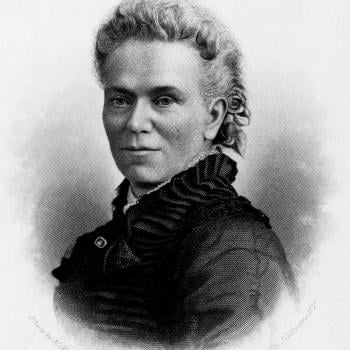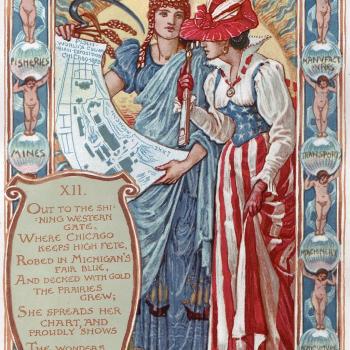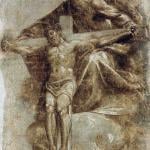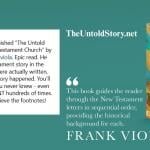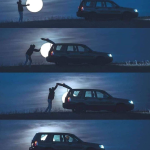The Anxious Bench focuses on the study of history, and particularly the history of religion and religions. I want to talk about what strikes me as a really major and valuable source for that study, but which is often neglected.
I am a great believer in the use of literature to illustrate strictly contemporary attitudes, in a way that is critical for social or cultural history. I have blogged here often on particular novels, including some American classics. But I focus here on using poetry as primary source material. If you are writing about Britain in the nineteenth century, you will be definitely be using contemporary poets for illustrations – Keats, Byron, Shelley, Tennyson. If you are working on the twentieth, there is no way you can’t use Auden and Philip Larkin. If you write about secularization and the Victorian crisis of faith, then you assuredly will be citing Matthew Arnold’s Dover Beach, and probably Arthur Hugh Clough’s Easter Day: Naples 1849. You can’t not. Those were significant and widely noted contributions to the then-flourishing conversation on faith and doubt. If it emerged that you didn’t even know those works, then you would be admitting that you really are not qualified to talk about that particular topic or era. A similarly obvious canon would immediately emerge for writing the history of France, say.
But in the US context, that is just not true. It’s not that the canon is not there, but it has slipped out of view. Please correct me if this statement is unfair, but Americans don’t seem anything like as conscious of their own really rich traditions, their own poetic canon, and they are missing some wonderful historical sources. I suppose a modern class on mass immigration around 1900 might well tackle Emma Lazarus and The New Colossus, but there is so much more, and better. Honestly, there really are some great American poets in that century between Walt Whitman and Howl. (I am biased on this topic because I have recently been reading a lot of Elizabeth Bishop).
At professional meetings, I have more than once had conversations like the following:
Distinguished and well-informed historian: “I’m working on [let’s say] American politics in the 1890s.”
Me: “Oh, I bet you are getting a lot out of all those poems by [REALLY famous poet] X. They’re such a great source for the attitudes then!”
Distinguished and well-informed historian: “Who is X?”
More to the point, it is not long since that X was extremely famous for any literate American. Throughout American history, poets have often enjoyed celebrity status to the point of being cultural superstars. These were the writers that everyone read if they had the slightest pretensions to literate status, or at least pretended to have read. I quote from a recent WSJ review about Longfellow in the 1850s and 1860s:
A master at what’s now called social networking, he commanded, at the height of his fame, a virtual empire of readers at home and abroad, a grateful audience larger than that of any American poet before or after him.
In later eras, I think of Robinson Jeffers, Robert Frost, Allen Ginsberg, and Maya Angelou, and you can fill in that list further. Except for people who define themselves as interested in literature, that poetic canon scarcely functions today, and historians don’t pay attention to those texts as potential sources. Is that an unfair comment?
Like every other combatant nation, the US produced its share of poetry about both world wars, not to mention the Civil War and many lesser conflicts, many by actual combatants. In their day, these were hugely famous, but have largely slipped from memory – in the First World War, think of Alan Seeger or Joyce Kilmer. They offer superb illustrations for writing or teaching. If you are illustrating anti-war sentiment in the Second World War – and yes, that did exist – read Robinson Jeffers.
If you are writing or teaching about African-American history, the Harlem Renaissance, or the New Negro, there are so many possible works by people like Langston Hughes or James Weldon Johnson. As a case in point, I was once teaching a course about US history between the two world wars, and was focusing on the horrific racial violence after 1918, with the Red Summer of 1919, and the Tulsa massacre of 1921. (We are just past the anniversary of Tulsa, which occurred on June 1, 1921). Of course, it all has a powerful contemporary relevance. How better to illustrate that story, and the mood of the time, than Claude McKay’s harrowing 1919 poem of stubborn resistance in the face of overwhelming violence, If We Must Die? Whatever its merits as poetry, it’s a superb teaching tool. That whole story was in my mind recently watching the stunning opening of the HBO series of The Watchmen, which reconstructs the Tulsa massacre.
Let me focus on maters of religion and faith. I have already posted at this site about some American poems, and some are really informative about religion. I talked about John Greenleaf Whittier’s The Brewing of Soma, which is a terrific piece about ideological splits in the 1870s between ritualist churches and their savage critics, from the point of view of a radical Quaker. It illustrates and illuminates the crucial idea of anti-Catholicism. I have posted about poems by Longfellow, Melville, and Robinson Jeffers, all to some extent discussing what those various works can tell us about religious thought, belief or culture at those particular times. I also wrote on a poem by the then popular Henry Van Dyke, for what that suggested about American knowledge of alternative gospels in the 1890s.
How did Americans respond to the crisis of faith in the late nineteenth and early twentieth centuries, to the impact of the Higher Criticism? Well, to find the answer, start by reading a novel, namely Harold Frederic’s The Damnation of Theron Ware. But after that, you read the poets, works such as Melville’s epic Clarel (1876), about which I will be posting soon.
To take another theme, when we read what major poets wrote about Buddhism, Hinduism, or Asian religions, it’s striking to see how very early those favorable ideas about non-Christian faiths penetrated American culture, certainly by the mid-nineteenth century. Lots of celebrity poets did write works like that – think of Emerson, Melville, or Vachel Lindsay, and this is all generations before the Beats.
In the coming couple of weeks, I will be offering several examples suggesting how such works can be used as historical sources, quite apart from their literary merits, which are often very considerable. In every case, I will be referring to contemporary poems written in a particular time that tell us about that time, or works written a bit later, but which are strictly autobiographical. That is, I’m referring to first-hand thoughts and observations, of primary sources.
Next time, I’ll look at one poem that in its way is an ideal American counterpart to Dover Beach, namely Wallace Stevens’s Sunday Morning.
One great source of ideas for possible poems is Harold Bloom, ed., American Religious Poems: An Anthology (Library of America 2006). As always, just ignore Bloom’s introduction.








